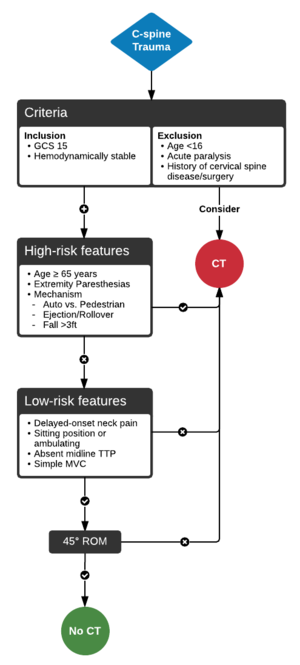We need you! Join our contributor community and become a WikEM editor through our open and transparent promotion process.
Canadian cervical spine rule
From WikEM
Contents
Background
- Only applies to GCS=15 and stable blunt neck trauma
- Not applicable for:
- Non-trauma, GCS <15, Hemodynamically unstable, Age <16, Acute paralysis, previous spinal disease or surgery
Rule
Canadian Cervical Spine Rule
No High Risk Factors
- Age >65
- Dangerous mechanism
- Parasthesias in extremities
ANY Low Risk Factor
- Simple rear end MVC
- Delayed onset of pain
- Sitting position in ED
- Ambulatory at any time
- Absence of midline C-spine tenderness
ROM
- Rotates neck 45 degrees to left and right
C-spine can be cleared clinically if above criteria met[1] [2]
Mnemonic
High Risk Rhyme
- Sixty five,
- Fast drive,
- Sense deprive
- (Image if alive)
Low Risk Rhyme
- Slow wreck,
- Slow neck,
- Sitting down,
- Walking around,
- C-spine fine
- (Range the spine)
See Also
- EBQ:Canadian C-spine Rule Study
- NEXUS cervical spine rule
- EBQ:NEXUS
- Blunt neck trauma
- Cervical spine clearance
- C-Spine X-Ray
External Links
References
- ↑ Stiell IG,et al. The Canadian C-spine rule for radiography in alert and stable trauma patients. JAMA. 2001 Oct 17;286(15):1841-8. EBQ:Canadian C-spine Rule Study
- ↑ Stiell IG, et al. The Canadian C-spine rule versus the NEXUS low-risk criteria in patients with trauma. N Engl J Med. 2003;349(26):2510-8.

